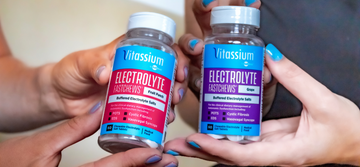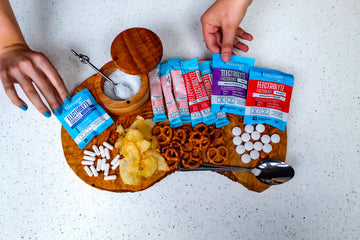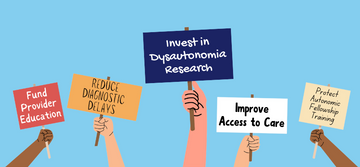
In September, SaltStick helped sponsor the 4th Annual Long Island CRPS Awareness Walk & Expo, hosted by the Reflex Sympathetic Dystrophy Syndrome Association (RSDSA). Each year, the event helps raise awareness for people living with Complex Regional Pain Syndrome (CRPS), a debilitating and chronic disorder that can cause unrelenting neurologic pain that trumps the pain of cancer, amputation and childbirth.
Debbie O’Neal, the event’s co-chair, developed CRPS in 2003 after a 50-pound box of steel fell and hit her while at work, leaving her permanently disabled. Along with being a proud wife, mother and grandmother, Debbie is a passionate advocate for spreading awareness about CRPS.
We recently spoke to Debbie about her experience living with CRPS, including the challenges, treatments and research that’s being done in the field. Below, you can find a transcript of our conversation, lightly edited for brevity and clarity.
Tell us about CRPS/RSD (General overview: symptoms, challenges).
No one really understands how or why some people are diagnosed with CRPS, previously known as RSD (Reflex Sympathetic Dystrophy). We do know it’s an auto-immune condition that affects the sympathetic nervous system. It can affect any body part or internal organs in those who are diagnosed. We also know that it can spread to other parts of the body as well. You can contract CRPS from things such as a crush injury (i.e. a heavy piece of metal falling on you), a sprained ankle, after surgery or from something as tiny as a needle prick.
An easy way to explain CRPS is that your brain is continuously misfiring, sending out signals that you’re in pain, but more severe than the injury experienced. It’s usually isolated to one area of the body, like an arm or leg but it can spread. Many people can experience a burning sensation in the affected area, similar to getting a third-degree sunburn. Additional symptoms include skin swelling, changes in skin color or texture, squeezing pain or intense pressure in the affected limb(s). There can also be extreme temperature changes for the affected area, sometimes upwards of five to ten degrees. No matter the symptoms, the more you use the affected limb or area, the more pain you’re going to be in.
Another symptom of CRPS is chronic sweating, which causes us to lose a lot of our electrolytes. In the past we thought our only option was sports drinks, which can help if you can tolerate drinking. However, when you experience pain levels such as ours, nausea is quite common, which makes drinking sometimes very difficult. For some, products like SaltStick have been a good option because they can be easier on our stomachs.
Everyday things can be incredibly challenging for those with CRPS. When we wake up in the morning, we have no idea where our pain level is going to be until we start moving. Even just going to family functions or the doctor’s office can be challenging. For me CRPS is in constant flux. Some days I’m in so much pain I have to stay in bed all day, and some days it can feel like your home has become your prison.
How large is the population of those affected with these conditions? Is there a “typical” profile of someone with CRPS?
The most common age for those with CRPS is between 20 and 35 years old. The government estimates that there are fewer than 200,000 people with CRPS, so it is still considered a rare disease, although RSDSA estimates that there are about 50,000 new cases a year in the United States. There is currently no tracking mechanism for how many people have been diagnosed across the world. At RSDSA we’re trying to find a way to compile all the data worldwide of those with this disease into a central system so we have a better understanding of how many people have been diagnosed and what treatments they are being prescribed.
How is CRPS diagnosed?
Diagnosing CRPS is often done by process of elimination. The biggest indicator is that the pain felt is disproportionate to the injury sustained. I was diagnosed with CRPS after getting hit on the shoulder with 50 pounds of steel while at my job. After getting hit, not only did my shoulder swell, but my hand did as well, which was the only reason I knew something was off because I couldn’t figure out why my hand was swelling.
We still don’t know what ultimately sparks CRPS. Because of this, there are no preventative measures that can be taken to ensure someone doesn’t get CRPS.
What kind of treatment is available for those with CRPS? What have you seen that’s most effective?
As is the case with many chronic diseases, what works for one person won’t necessarily work for another. Because of this, there are many different treatments for CRPS. The most common treatments are pain medication, including opioids and ketamine infusions. A lot of people will have stimulators implanted in their body, which are attached to a specific nerve or the spinal column to intercept the faulty pain signals that your brain sends. Hyperbaric oxygen chambers can also help, and RSDSA is working with a study to further examine this technology as a solution.

What type of physician treats CRPS?
Most people are treated by a pain management doctor. Orthopedic doctors, neurologists and physical therapists can also help someone with CRPS. A lot of people also find themselves needing to see a pain psychologist because when you’re diagnosed with something like CRPS, you lose a physical aspect of yourself. For me, I was a swimmer and loved riding my bike and rollerblading. I can’t do any of those things anymore. Following diagnoses, those with CRPS can experience severe depression due to the reality and severity of the condition, so a pain psychologist can really help with that.
Sadly, in medical or nursing school they don’t teach a whole lot about pain management, so RSDSA is working hard to change that curriculum. Recently there were two additions in New York State: There were questions added about CRPS on the Nursing Medical Boards and to the exam tests for Physician Assistants.
What are common misconceptions about people with CRPS/RSD?
The biggest misconception is that we’re faking our symptoms, because most of us don’t outwardly look like there is anything wrong. People often don’t understand you can’t get out of bed or can break down crying while trying to walk a short distance. There’s a pain scale that doctors use called the McGill pain index, which ranks pain from 1 to 50, with 50 being the most painful. CRPS is a 46, higher than kidney stones or amputation of a finger.
I’ve personally experienced this misconception with my loved ones. It took my brother years to understand that CRPS is even a real condition.
What are the most helpful things that have been offered to you (meaning what can someone close to you do to help you?)
I’m thankful to have a husband who does anything and everything he can for me when I’m in a bad flair. He handles the mundane tasks, such as cooking dinner, doing the laundry or driving me around. CRPS brings with a lot of challenges to a person’s everyday life.
There can be a lot of guilt, though, in asking people to help you. You don’t want to be hurting so bad that your family has to start doing things for you because you literally can’t. But it’s the reality for many of us living with this condition. I also find support groups, whether in your area or online, can also be very helpful.
There is always hope for a cure. I’ll never give up hope.
Talk about the researching being done on CRPS. Is there hope for a cure?
There is always hope for a cure. I’ll never give up hope. As far as research, there are several medical trials that are currently taking place. One trial is for a medical device used to manage pain. The University of Bath is in the midst of a study focused on young people who have CRPS and how they think about their future.
There’s also a virtual reality (VR) pain management clinical trial taking place to see how we can utilize virtual reality to control pain. The thought behind this is to help divert your mind away from the pain by putting you in the midst of an alternate reality. The researchers behind this study also want to see if VR can help those with phantom limb pain because unfortunately, a lot of the time those with CRPS will choose to have the limb that is causing the pain amputated. There’s a national studying being done on patient-defined recovery, or seeing how long it takes a person to heal if they get injured after being diagnosed with CRPS.
For those interested in a full list of clinical trials currently being done, you can visit RSDSA’s website.

How does your organization support those with these conditions?
CRPS can be incredibly isolating, making those of us with it literally prisoners in our own homes. We feel events such as the annual Long Island CRPS Awareness Walk and Expo are important because they let people know they’re not alone and there are people out there that intimately know what they’re going through. RSDSA also sponsors a young adult weekend and a week-long pediatric camp for children diagnosed with CRPS along with their parents and siblings.
RSDSA also puts on conferences throughout the nation for doctors, nurses and healthcare professionals, as well as those with CRPS, aimed at educating them about this condition. For example, we’re currently offering a course on pediatric pain management that doctors and nurses can take for credit.
Unfortunately, for a lot of people diagnosed with CRPS, their families just don’t understand what they’re going through. This is one of the reasons why my co-chairs and I decided to do The Long Island CRPS Awareness Walk & Expo. We wanted others with CRPS to know they are not alone. We want to educate family and friends, as well as the medical community. The funds we raise go directly to RSDSA so they can continue their mission to provide support, education and hope to all affected by the pain and disability of CRPS, while driving research to develop better treatments and a cure.
You can learn more about RSDSA here.







